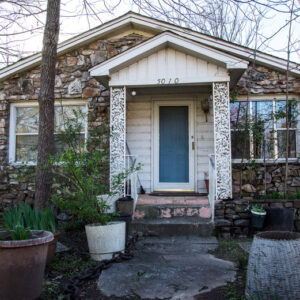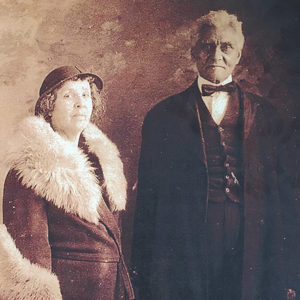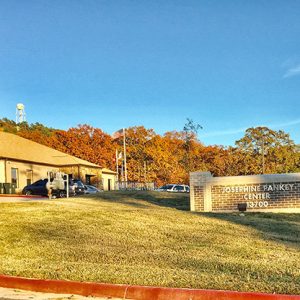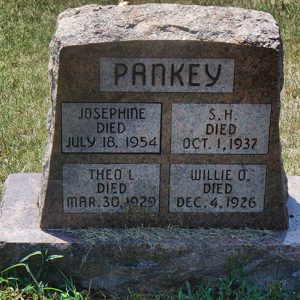calsfoundation@cals.org
Josephine Irvin Harris Pankey (1869–1954)
Josephine Irvin Harris Pankey was a real estate developer, educator, philanthropist, and leader in the African-American community of Little Rock (Pulaski County) for the first half of the twentieth century.
Josephine Irvin was born on November 17, 1869, in Cleveland, Ohio. Her parents were William R. Irvin and Katherine Harris Irvin. She was the oldest of their five children. Her father was a self-employed whitewasher, her mother a homemaker. Irvin attended elementary school in Cleveland, including at Oberlin College’s Academy, a preparatory school connected with the college. After graduation, she enrolled in Oberlin College but withdrew because of an illness. She was musically talented and studied at the conservatory that was connected with the academy and the college.
By 1892, she had moved from Cleveland to Arkansas to serve as a teacher and missionary for the African Methodist Episcopal Zion Church. She began her teaching career in DeValls Bluff (Prairie County) and soon became the principal of a group of African-American schools that were scattered around the lower White River. She traveled via horse and wagon to oversee these schools, most of which were taught by women younger than herself.
In 1898, she married Eugine Harris of DeValls Bluff, and the couple moved to Pine Bluff (Jefferson County). There, she taught and gave music lessons. Her husband worked as a shingle sawyer. After three years of marriage, they divorced, and she moved to Little Rock. She continued teaching and joined Bethel African Methodist Episcopal Church. There, she met Samuel Pankey, a postal worker and a widower with seven children, four of whom were still living at home. They were married in 1904.
Not long after their marriage, the couple became interested in real estate development. But in the early 1900s in Little Rock, restrictive covenants limited where black families could buy land and live, and financing was not generally available from banks. Josephine Pankey began to address both of these issues. She began her real estate career in 1907 when she bought eighty acres located thirteen miles west of downtown Little Rock, along what is now called Cantrell Road. The price was $400, and this first purchase was the basis of Pankey’s best-known and largest development, which is still known as the Pankey community. Although it was her first purchase, she waited two years before beginning to develop it.
Less than a year after her first purchase, she bought two and a half acres off what is now North Cleveland Street, between Hall High and Catholic High. The price was $500. This was the first land that she had surveyed and platted, making twelve lots. She and her husband built a home and moved there from downtown. In 1910, Pankey bought another fifteen acres near what today is Kanis Road and Boyle Park; it was developed into seventy-two lots. In 1922, she bought eighty acres adjacent to her first purchase (which by then had been platted into 384 lots) and platted an additional 348 lots. Later, she bought more land in the area. At its peak, the Pankey community stretched for several miles along Cantrell Road, on both the northern and southern sides of the current roadway.
At the same time that she was developing these three major tracts, she was collaborating with other developers on smaller tracts and selling individual lots. She also began working with Worthen Bank, arranging loans for her buyers. Aubrey Williams, who worked in the personal loan department at Worthen, recalled in a 1991 letter: “On the strength of Mrs. Pankey’s endorsement, the bank made a number of loans to young men who otherwise would not have qualified for a loan. If the borrower didn’t pay the note to the bank, I would call Mrs. Pankey. Sometimes she would ask us to give the borrower more time, if he had a good excuse, such as illness or unemployment.”
Pankey also wanted a better life for the residents of her community. When she was a young woman, in addition to her regular teaching duties, she helped organize schools in African-American communities that had none. She organized the first school in the Riverside community, known today as the Riverdale area of Little Rock. Seeing that African-American children and families lacked access to books and were unable to use local libraries because of segregation laws, Pankey started her own lending library, initially out of the back of a horse-drawn wagon. Eventually, she established the first permanent lending library for African Americans in Little Rock. Pankey led community members in lobbying the Pulaski County Special School District to establish a district school in Pankey, which was finally done. In the 1920s, 1930s, and into 1940s, it was only a one-room school, with one teacher to serve students of all ages. In the 1950s, the district finally built a new school in Pankey on land donated by Pankey. It served approximately 200 African-American students from across the western part of Pulaski County and was a hub for the community until its closure.
Pankey was an active volunteer and major financial supporter of the Ninth Street USO that served black soldiers during World War II. She supported the local African-American Young Women’s Christian Association (YWCA). The Girl Reserves, as young African-American YWCA members were called, often had campouts in the undeveloped portion of Pankey’s Addition because the girls were not allowed to camp with the white YWCA girls.
The Pankeys, and probably most African Americans in Little Rock, were affected by the May 1927 lynching of John Carter at 9th and Broadway, in the middle in the African-American business district. After the lynching, the Pankeys quickly moved from their home near 9th and Jones to a small house in Pankey, which initially had no electricity or gas. It was difficult to obtain a phone line in the community then, so Pankey rented office space downtown and commuted between rural Pankey and downtown Little Rock.
Pankey’s husband died in 1937, but she continued her real estate development and charitable work until 1947, when she officially retired. She lived in Pankey until her death on July 19, 1954. She and her husband are buried in Oakland-Fraternal Cemetery in Little Rock.
In 1979, the City of Little Rock annexed the Pankey community. By the beginning of the twenty-first century, many of the community’s businesses had moved or closed, and the area had lost much of its former vibrancy and unity. But Josephine Pankey is still remembered, and a cookbook compiled by the Pankey Community Association is titled Josephine Pankey Cooks with Friends. In it, the authors recalled their founding mother as “second-to-none when it came to love and devotion to her community and her people. Until her death, she led the movement to improve the quality of life of the citizens of Pankey.”
For additional information:
Dillard, Tom. “Josephine Pankey.” Arkansas Democrat-Gazette, November 22, 2015, p. 4H.
Josephine Pankey Cooks with Friends. Little Rock: Pankey Community Association, n.d.
“Letter to the Editor.” Pulaski County Historical Review 39 (Spring 1991): 24.
“Pulaski Profiles: Josephine and Samuel Pankey.” Pulaski County Historical Review 38 (Fall 1990): 58.
Robinson Lott, Nancy, and Regina Norwood. Josephine: Celebrating the Life and Legacy of Mrs. Josephine Irvin Harris Pankey. Little Rock: Friends of Josephine Pankey, 2012.
Marion Fulk
Little Rock, Arkansas
 Business, Commerce, and Industry
Business, Commerce, and Industry Early Twentieth Century, 1901 through 1940
Early Twentieth Century, 1901 through 1940 Education, Elementary and Secondary
Education, Elementary and Secondary Pankey House
Pankey House  Josephine and Samuel Pankey
Josephine and Samuel Pankey  Josephine Pankey Center
Josephine Pankey Center  Pankey Gravestone
Pankey Gravestone 




Thank you for including this biography of Mrs. Josephine Pankey. She was a very savvy businesswoman. Per the two deeds for the 160 acres plots that she purchased from Mrs. Jenny Ives: one down payment of $100 and the balance of $300 was paid annually. She used the money from the sale of the lots to make these payments.